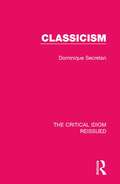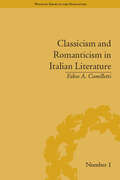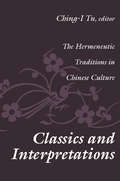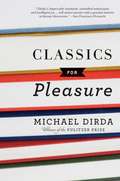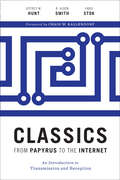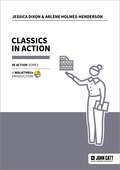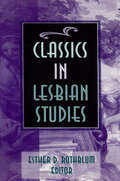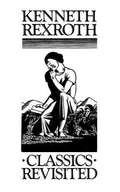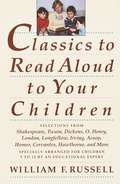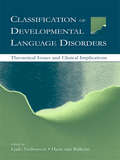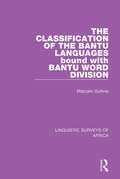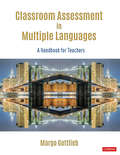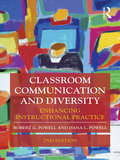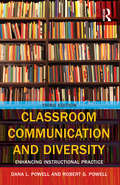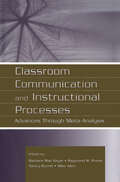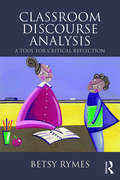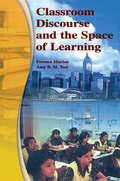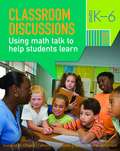- Table View
- List View
Classical Victorians
by Edmund RichardsonVictorian Britain set out to make the ancient world its own. This is the story of how it failed. It is the story of the headmaster who bludgeoned his wife to death, then calmly sat down to his Latin. It is the story of the embittered classical prodigy who turned to gin and opium - and the virtuoso forger who fooled the greatest scholars of the age. It is a history of hope: a general who longed to be an Homeric hero, a bankrupt poet who longed to start a revolution. Victorian classicism was defined by hope - but shaped by uncertainty. Packed with forgotten characters and texts, with the roar of the burlesque-stage and the mud of the battlefield, this book offers a rich insight into nineteenth-century culture and society. It explores just how difficult it is to stake a claim on the past.
Classicism (The Critical Idiom Reissued #26)
by Dominique SecretanFirst published in 1972, this book provides an overview of Classicism in literature. After an informative introduction to the term, it explores some of the periods and places in which Classicism has been prominent: the Italian Renaissance, England before and during the Restoration, Renaissance France and eighteenth-century Germany. In avoiding a rigid definition of Classicism, this book demonstrates its multiplicity and changeability across time periods, as well as its limits.
Classicism and Romanticism in Italian Literature: Leopardi's Discourse on Romantic Poetry (Warwick Series in the Humanities #1)
by Fabio A CamillettiIn 1816 a violent literary quarrel engulfed Bourbon Restoration Italy. On one side the Romantics wanted an opening up of Italian culture towards Europe, and on the other the Classicists favoured an inward-looking Italy. Giacomo Leopardi wrote a Discourse of an Italian on Romantic Poetry aiming to contribute to the debate from a new perspective.
Classics after Antiquity: Modernism and Homer
by Leah Culligan FlackThis comparative study crosses multiple cultures, traditions, genres, and languages in order to explore the particular importance of Homer in the emergence, development, and promotion of modernist writing. It shows how and why the Homeric epics served both modernist formal experimentation, including Pound's poetics of the fragment and Joyce's sprawling epic novel, and sociopolitical critiques, including H. D. 's analyses of the cultural origins of twentieth-century wars and Mandelstam's poetic defiance of the totalitarian Stalinist regime. The book counters a long critical tradition that has recruited Homer to consolidate, champion and, more recently, chastise an elitist, masculine modernist canon. Departing from the tradition of reading these texts in isolation as mythic engagements with the Homeric epics, Leah Flack argues that ongoing dialogues with Homer helped these writers to mount their distinct visions of a cosmopolitan post-war culture that would include them as artists working on the margins of the Western literary tradition.
Classics and Commercials: A Literary Chronicle of the Forties
by Edmund WilsonClassics and Commercials: A Literary Chronicle of the Forties showcases Edmund Wilson's critical writings spanning decades and continents. Many of these essays first appeared in the New Yorker.Here is Wilson on Jane Austen, Thackeray, Edith Wharton, Tolstoy, Swift (the classics) as well as brilliant observations on Poe, H.P Lovecraft, detective stories, and other commercial literature. This wide-ranging study from one of the most influential man of letters demonstrates Wilson's supreme skills as both literary and cultural critic.
Classics and Interpretations: The Hermeneutic Traditions in Chinese Culture
by Ching I TuIn recent years in the "West," scholars have attempted to unravel old constructs of interpretation and understanding, using the discipline of hermeneutics, or the scientific study of textual interpretation. Borrowed from students of the ever growing body of biblical interpretive literature that originated in the early Christian era, theoretical hermeneutics has given many contemporary scholars potent tools of textual interpretation. Classics and Interpretations applies this method to Chinese culture. Several essays focus on hermeneutic traditions of Neo-Confucianism. Others move outside of these traditions to attempt an understanding of the role of hermeneutics in Taoist and Buddhist textual interpretation, in Chinese poetics and painting, and in contemporary Chinese culture.This volume makes a concerted effort to remedy our ignorance of the Chinese hermeneutical tradition. Part 1, "The Great Learning and Hermeneutics," demonstrates the use of commentary to define how the individual creates his social self, and discusses differing interpretations of the Ta-hsueh text and its treatment as either canonical or heterodox. Part 2, "Canonicity and Orthodoxy," considers the philosophical touchstones employed by Neo-Confucian canonical exegetes and polemicists, and discusses the Han canonization of the scriptural Five Classics, while illuminating a double standard that existed in the hermeneutical regime of late imperial China. Part 3, "Hermeneutics as Politics," discusses the transformation of both the classics and scholars, and explores the dominant hermeneutic tradition in Chinese historiography, the scriptural tradition and reinterpretation of the Ch'un-ch'iu, and reveals the pragmatism of Chinese hermeneutics through comparison of the Sung debates over the Mencius. The concluding sections include essays on "Chu Hsi and Interpretation of Chinese Classics," "Hermeneutic Traditions in Chinese Poetics and Non-Confucian Contexts," "Reinterpretation of Confucian Texts in the Ming-Ch'ing Period," and "Contemporary Interpretations of Confucian Culture."Through these literate and brilliantly written essays the reader witnesses not merely the great breadth and depth of Chinese hermeneutics but also its continuity and evolutionary vigor. This volume will excite scholars of the Confucian, Buddhist, and Taoist systems of thought and belief as well as students of history and hermeneutics.
Classics for Pleasure
by Michael DirdaIn these delightful essays, Pulitzer Prize winner Dirda introduces nearly 90 of the world's most entertaining books, covering masterpieces of fantasy, science fiction, horror, adventure, epics, history, and children's literature.
Classics from Papyrus to the Internet: An Introduction to Transmission and Reception (Ashley and Peter Larkin Series in Greek and Roman Culture)
by Jeffrey M. Hunt R. Alden SmithA &“valuable and useful&” history of the efforts and innovations that have kept ancient literary classics alive through the centuries (New England Classical Journal). Writing down the epic tales of the Trojan War and the wanderings of Odysseus in texts that became the Iliad and the Odyssey was a defining moment in the intellectual history of the West, a moment from which many current conventions and attitudes toward books can be traced. But how did texts originally written on papyrus in perhaps the eighth century BC survive across nearly three millennia, so that today people can read them electronically on a smartphone? Classics from Papyrus to the Internet provides a fresh, authoritative overview of the transmission and reception of classical texts from antiquity to the present. The authors begin with a discussion of ancient literacy, book production, papyrology, epigraphy, and scholarship, and then examine how classical texts were transmitted from the medieval period through the Renaissance and the Enlightenment to the modern era. They also address the question of reception, looking at how succeeding generations responded to classical texts, preserving some but not others. This sheds light on the origins of numerous scholarly disciplines that continue to shape our understanding of the past, as well as the determined effort required to keep the literary tradition alive. As a resource for students and scholars in fields such as classics, medieval studies, comparative literature, paleography, papyrology, and Egyptology, Classics from Papyrus to the Internet presents and discusses the major reference works and online professional tools for studying literary transmission.
Classics in Action
by Jessica Dixon Dr Arlene Holmes-HendersonClassics is one of the most varied and interdisciplinary of all subjects; it includes literature, history, philosophy, art and archaeology. There is growing interest among teachers in the subject, and recent studies have shown that learning Latin and/or Greek can have a positive impact on student outcomes in English and literacy.Jessica Dixon and Arlene Holmes-Henderson showcase ideas from their own teaching experience, plus innovative examples from a range of schools, to provide strategies for teaching Latin, Greek, Classical Civilisation and Ancient History that will enrich, enliven and extend your teaching practice.Inspiring and eye-opening, this will be an enjoyable and useful read for all teachers who are currently teaching, training to teach, or interested in teaching classical subjects and related disciplines, in primary or secondary schools.
Classics in Action
by Jessica Dixon Dr Arlene Holmes-HendersonClassics is one of the most varied and interdisciplinary of all subjects; it includes literature, history, philosophy, art and archaeology. There is growing interest among teachers in the subject, and recent studies have shown that learning Latin and/or Greek can have a positive impact on student outcomes in English and literacy.Jessica Dixon and Arlene Holmes-Henderson showcase ideas from their own teaching experience, plus innovative examples from a range of schools, to provide strategies for teaching Latin, Greek, Classical Civilisation and Ancient History that will enrich, enliven and extend your teaching practice.Inspiring and eye-opening, this will be an enjoyable and useful read for all teachers who are currently teaching, training to teach, or interested in teaching classical subjects and related disciplines, in primary or secondary schools.
Classics in Lesbian Studies
by Esther D RothblumClassics in Lesbian Studies takes a major step in giving the lesbian experience its own unique voice within scholarship and the larger world society. Thus, it is devoted exclusively to the lesbian experience and serves as a vehicle for the promotion of scholarship and commentary on lesbianism from an international perspective. Not only does it ensure that “classic” pieces are not forgotten by new generations of students and scholars, it also spurs further lesbian research, writing, theory, and scholarship.In Classics in Lesbian Studies, you are introduced to descriptive, theoretical, empirical, applied, and multicultural perspectives in the field of lesbian studies. Interdisciplinary, the book presents pieces from various academic areas in multiple formats, including personal accounts, poetry, editorials, debates, and commentaries. For your convenience, the chapters are organized primarily across four categories: identity, history and literature, physical and social sciences, and “back to lesbian politics.” You will find the discussions of the following issues and subjects provocative and insightful: ways black women in the diaspora construct and name their sexual and romantic feelings for other women lesbian identity formation in a changing social environment how lesbians maneuver in the dominant culture and their own subculture lesbianism as a political movement the experiences of lesbian adolescents teaching lesbian studies lesbians and societal institutions, including the work place, the media, the political arena, the legal system, and religion using lesbian-feminist scholarship to reexamine women's lives in the pastStudents, scholars, lesbian feminists, and others interested in lesbian studies will find Classics in Lesbian Studies a vital examination of lesbianism since its grass roots. Not only does it consider the progress made since the initial days of fighting for liberation, it also explores a more distant, repressed past and anticipates future possibilities lying before us. This powerful, insightful collection is sure to become a classic as it grapples with virtually all aspects of lesbianism, from its inception as a political movement to its identity as a lifestyle choice to its implications of community.
Classics Revisited
by Kenneth Rexroth Bradford MorrowThe history of, and comments about, 60 classic pieces of literature, ranging from Gilgamesh to Huckleberry Finn.
Classics to Read Aloud to Your Children: Selections from Shakespeare, Twain, Dickens, O.Henry, London, Longfellow, Irving Aesop, Homer, Cervantes, Hawthorne, and More
by William F. RussellA perennially popular collection of short stories, poems, legends, and myths from great works of literature that are especially appropriate for parents to read aloud to their children aged five to twelve. Line drawings.From the Trade Paperback edition.
Classification of Developmental Language Disorders: Theoretical Issues and Clinical Implications
by Ludo Verhoeven Hans Van BalkomChapters written by leading authorities offer current perspectives on the origins and development of language disorders. They address the question: How can the child's linguistic environment be restructured so that children at risk can develop important adaptive skills in the domains of self-care, social interaction, and problem solving? This theory-based, but practical book emphasizes the importance of accurate definitions of subtypes for assessment and intervention. It will be of interest to students, researchers, and practitioners in the field of developmental language disorders.
The Classification of the Bantu Languages bound with Bantu Word Division (Linguistic Surveys of Africa #11)
by Malcolm GuthrieThe first volume of this pair, The Classification of Bantu Languages, originally published in 1948, investigates the questions arising out of the use of the term Bantu. It establishes and illustrates the criteria used in identifying languages as members of the Bantu family. The technique used in classification is described and its results shown in the form of a series of descriptive classifications of each of the principal areas. As well as the map (not included in the volume due to modern methods of reproduction, but available to view on routledge.com), there is a complete list of languages classified in their groups. The second volume, Bantu Word Division published in the same year, discusses a question which for many years was the subject of protracted controversy, namely the dispute between the conjunctivist and the disjunctivist, with regard to word division. This pamphlet discusses word division from a different angle, and solves the problem in a more conclusive way.
Classroom Assessment in Multiple Languages: A Handbook for Teachers
by Margo GottliebWhat if multilingual learners had the freedom to interact in more than one language with their peers during classroom assessment? What if multilingual learners and their teachers in dual language settings had opportunities to use assessment data in multiple languages to make decisions? Just imagine the rich linguistic, academic, and cultural reservoirs we could tap as we determine what our multilingual learners know and can do. Thankfully, Margo Gottlieb is here to provide concrete and actionable guidance on how to create assessment systems that enable understanding of the whole student, not just that fraction of the student who is only visible as an English learner. With Classroom Assessment in Multiple Languages as your guide, you’ll: Better understand the rationale for and evidence on the value and advantages of classroom assessment in multiple languages Add to your toolkit of classroom assessment practices in one or multiple languages Be more precise and effective in your assessment of multilingual learners by embedding assessment as, for, and of learning into your instructional repertoire Recognize how social-emotional, content, and language learning are all tied to classroom assessment Guide multilingual learners in having voice and choice in the assessment process Despite the urgent need, assessment for multilingual learners is generally tucked into a remote chapter, if touched upon at all in a book; the number of resources narrows even more when multiple languages are brought into play. Here at last is that single resource on how educators and multilingual learners can mutually value languages and cultures in instruction and assessment throughout the school day and over time. We encourage you to get started right away. “Margo Gottlieb has demonstrated why the field, particularly the field as it involves the teaching of multilingual learners, needs another assessment book, particularly a book like this. . . . Classroom Assessment in Multiple Languages quite likely could serve as a catalyst toward the beginning of an enlightened discourse around assessment that will benefit multilingual learners.” ~Kathy Escamilla
Classroom Assessment in Multiple Languages: A Handbook for Teachers
by Margo GottliebWhat if multilingual learners had the freedom to interact in more than one language with their peers during classroom assessment? What if multilingual learners and their teachers in dual language settings had opportunities to use assessment data in multiple languages to make decisions? Just imagine the rich linguistic, academic, and cultural reservoirs we could tap as we determine what our multilingual learners know and can do. Thankfully, Margo Gottlieb is here to provide concrete and actionable guidance on how to create assessment systems that enable understanding of the whole student, not just that fraction of the student who is only visible as an English learner. With Classroom Assessment in Multiple Languages as your guide, you’ll: Better understand the rationale for and evidence on the value and advantages of classroom assessment in multiple languages Add to your toolkit of classroom assessment practices in one or multiple languages Be more precise and effective in your assessment of multilingual learners by embedding assessment as, for, and of learning into your instructional repertoire Recognize how social-emotional, content, and language learning are all tied to classroom assessment Guide multilingual learners in having voice and choice in the assessment process Despite the urgent need, assessment for multilingual learners is generally tucked into a remote chapter, if touched upon at all in a book; the number of resources narrows even more when multiple languages are brought into play. Here at last is that single resource on how educators and multilingual learners can mutually value languages and cultures in instruction and assessment throughout the school day and over time. We encourage you to get started right away. “Margo Gottlieb has demonstrated why the field, particularly the field as it involves the teaching of multilingual learners, needs another assessment book, particularly a book like this. . . . Classroom Assessment in Multiple Languages quite likely could serve as a catalyst toward the beginning of an enlightened discourse around assessment that will benefit multilingual learners.” ~Kathy Escamilla
Classroom-based Conversation Analytic Research: Theoretical and Applied Perspectives on Pedagogy (Educational Linguistics #46)
by Olcay Sert Silvia Kunitz Numa MarkeeThis book presents an international range of conversation analytic (CA) studies of classroom interaction which all discuss their empirical findings in terms of their theoretical and methodological contribution to the field of second language studies and their potential pedagogical relevance. The volume is thus unique in its focus on the theoretical and practical insights of CA classroom-based research and on the impact that such insights might have at the pedagogical level, from teaching to testing to teacher education. Given the growing interest in the pedagogical applicability of CA research, this book is a timely addition to the existing literature.
Classroom Communication and Diversity: Enhancing Instructional Practice
by Robert G. Powell Dana L. PowellClassroom Communication and Diversity is an integral resource for teaching awareness of diversity issues and communication in the classroom. Drawing on the research in the communication and education disciplines, authors Robert G. Powell and Dana Caseau provide theoretical models and useful strategies for improving instructional practices. They address the ways in which culture influences communication in the classroom, and assist teachers in developing the skills necessary to meet the needs of the students in their classrooms. New to the second edition is an expanded skills component, additional teaching resources, and an increased focus on the role of diversity in the classroom. Much of the information shared in this text derives from the authors' research and experience in schools and from the experiences of others, including teachers, parents, and children. Their experiences, combined with the cross-disciplinary approach, produce a volume of unique perspectives and considerable insight.
Classroom Communication and Diversity: Enhancing Instructional Practice (Routledge Communication Series)
by Robert G. Powell Dana L. PowellClassroom Communication and Diversity provides a useful framework for helping both new and experienced teachers and instructors navigate the communication challenges in today’s diverse classroom. It encourages teachers to reflect on how their personal cultures influence their expectations regarding classroom communication. This textbook is distinctive in its distillation of research from numerous sources to provide the best viewpoint and systems for focusing on the needs of the individual learner. Dana L. Powell and Robert G. Powell draw on research in both the communication and education disciplines, and provide useful strategies for improving teaching practices alongside theoretical models regarding diversity in the classroom. Much of the information found in this text is also inspired by the authors’ direct experience in schools and from the experience they have gleaned from other first-line instructors as well as from parents and children. Among the many updates to this Third Edition are: Expanded coverage of students with diverse needs Discussion on working effectively with parents Coverage of cultural influences and the impact of race and ethnicity on disciplinary actions Examination of the role of social media and its impact on instructional communication The increase of educational technology use. Teachers and scholars in the communication and education fields will find this text practical and valuable for their teaching efforts, and it is appropriate for instructional communication courses in both disciplines.
Classroom Communication and Instructional Processes: Advances Through Meta-Analysis (Routledge Communication Series)
by Mike Allen Barbara Mae Gayle Raymond W. Preiss Nancy BurrellThis volume offers a systematic review of the literature on communication education and instruction. Making meta-analysis findings accessible and relevant, the editors of this volume approach the topic from the perspective that meta-analysis serves as a useful tool for summarizing experiments and for determining how and why specific teaching and learning experiences have positive student outcomes. The topics covered here are meaningful and relevant to classroom practice, and each chapter offers a summary of existing quantitative social science research using meta-analysis. With contributions from experienced researchers throughout the communication discipline, this work provides a unique analysis of research in instructional communication.Taken together, the chapters in this volume enhance understanding of behaviors, practices, and processes that promote positive student outcomes. This book is a must-read for scholars, graduate students, and researchers in communication education, and will also be of interest to scholars and researchers in education.
Classroom Discourse Analysis: A Tool For Critical Reflection, Second Edition
by Betsy RymesThis second edition of Classroom Discourse Analysis continues to make techniques widely used in the field of discourse analysis accessible to a broad audience and illustrates their practical application in the study of classroom talk, ideal for upper-level undergraduate and graduate students in discourse analysis, applied linguistics, and anthropology and education. Grounded in a unique tripartite "dimensional approach," individual chapters investigate interactional resources that model forms of discourse analysis teachers may practice in their own classrooms while other chapters provide students with a thorough understanding of how to actually collect and analyse data. The presence of a number of pedagogical features, including activities and exercises and a comprehensive glossary help to enhance students‘ understanding of these key tools in classroom discourse analysis research. Features new to this edition reflect current developments in the field, including: increased coverage of peer interaction in the classroom greater connecting analysis to curricular and policy mandates and standards-based reform movements sample excerpts from actual student classroom discourse analysis assignments a new chapter on the repertoire approach, an increasingly popular method of analysis of particular relevance to today’s multilingual classrooms
Classroom Discourse and the Space of Learning
by Ference Marton Amy B.M. Tsui Pakey P.M. Chik Po Yuk Ko Mun Ling LoClassroom Discourse and the Space of Learning is about learning in schools and the central role of language in learning. The investigations of learning it reports are based on two premises: First, whatever you are trying to learn, there are certain necessary conditions for succeeding--although you cannot be sure that learning will take place when those conditions are met, you can be sure that no learning will occur if they are not. The limits of what is possible to learn is what the authors call "the space of learning." Second, language plays a central role in learning--it does not merely convey meaning, it also creates meaning. The book explicates the necessary conditions for successful learning and employs investigations of classroom discourse data to demonstrate how the space of learning is linguistically constituted in the classroom.Classroom Discourse and the Space of Learning:*makes the case that an understanding of how the space of learning is linguistically constituted in the classroom is best achieved through investigating "classroom discourse" and that finding out what the conditions are for successful learning and bringing them about should be the teacher's primary professional task. Thus, it is fundamentally important for teachers and student teachers to be given opportunities to observe different teachers teaching the same thing, and to analyze and reflect on whether the classroom discourse in which they are engaged maximizes or minimizes the conditions for learning;*is both more culturally situated and more generalizable than many other studies of learning in schools. Each case of classroom teaching clearly demonstrates how the specific language, culture, and pedagogy molds what is happening in the classroom, yet at the same time it is possible to generalize from these culturally specific examples the necessary conditions that must be met for the development of any specific capability regardless of where the learning is taking place and what other conditions might be present; and *encompasses both theory and practice--providing a detailed explication of the theory of learning underlying the analyses of classroom teaching reported, along with close analyses of a number of authentic cases of classroom teaching driven by classroom discourse data which have practical relevance for teachers.Intended for researchers and graduate students in education, teacher educators, and student teachers, Classroom Discourse and the Space of Learning is practice- and content-oriented, theoretical, qualitative, empirical, and focused on language, and links teaching and learning in significant new ways.
Classroom Discussions: Using Math Talk to Help Students Learn, Grades K-6 (2nd edition)
by Suzanne H. Chapin Catherine O'Connor Nancy Canavan AndersonThis best-selling resource offers an unparalleled look at the significant role that classroom discussions can play in teaching mathematics. New to this edition are more research-based examples of classroom talk at early grade levels, an expanded range of vignettes, discussion questions at the end of each chapter, and connections to NCTM standards.

